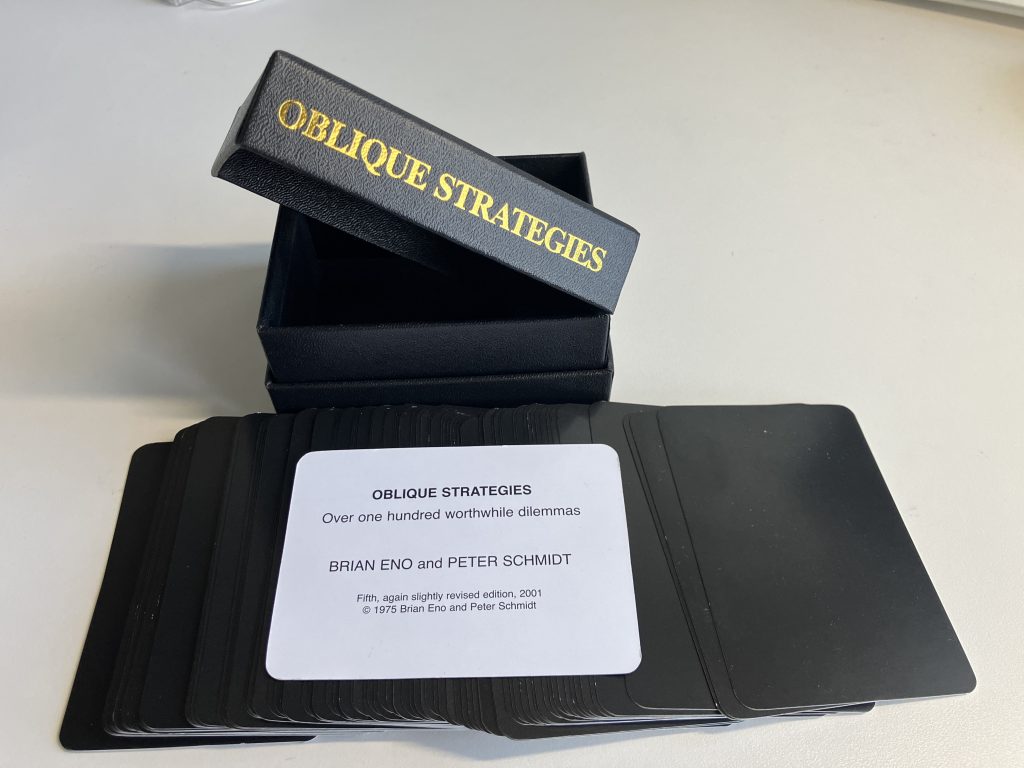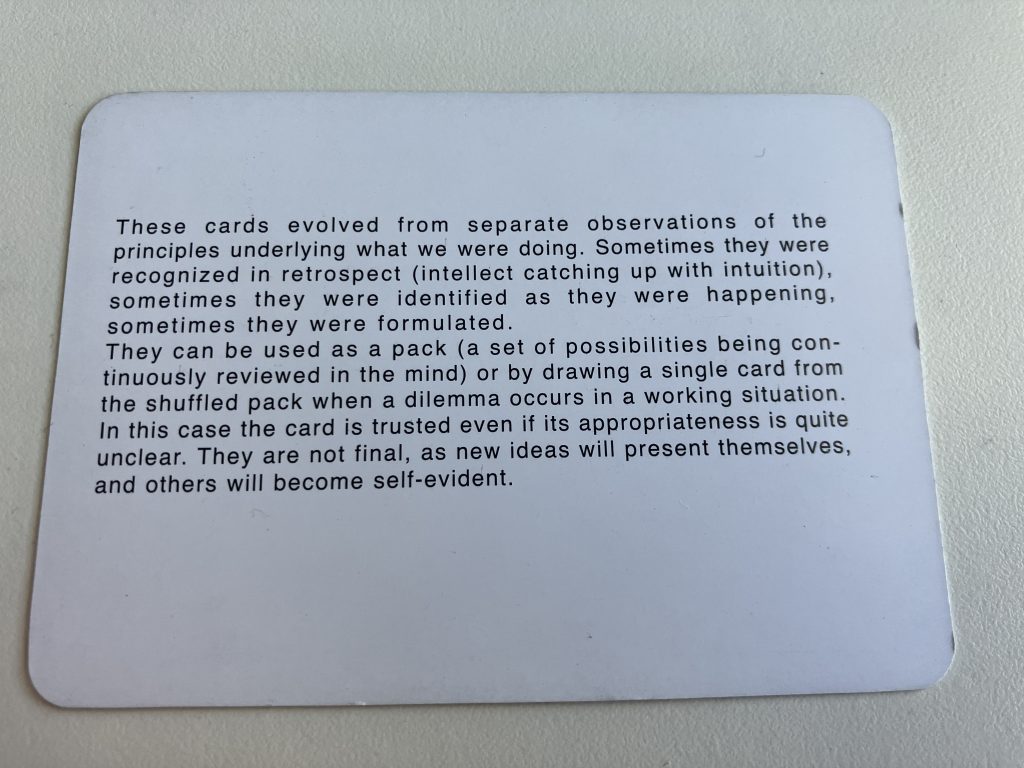Are you someone who likes everything to be thoughtfully planned and organised, or are you more spontaneous? Depending on your personality, you may fit into one of these categories or sway between these groups. In our daily lives, most of us subconsciously stick to our own regular routines – after all, familiarity can provide comfort and reassurance, especially during times of instability.
I would put myself in the first category, as I’m typically someone who prefers a structured environment with things planned out in advance. However, life doesn’t normally work this way, as we face randomness and obstacles on an almost daily basis. But what if we didn’t view these obstacles as threats, but rather opportunities in disguise?
Oblique strategies
In 1975, Brian Eno and Peter Schmidt published Oblique Strategies, a set of cards containing various phrases and aphorisms to provoke alternative ways of thinking. Originally designed to inspire new ideas in musicians facing writer’s block, the cards are a useful tool to encourage fresh perspectives when faced with a lack of inspiration and creativity.


Brian Eno is a renowned English musician who has collaborated with big names in the music industry, perhaps none larger than David Bowie. Eno would regularly meet with Bowie in the late 1970s to record music, bringing the cards containing peculiar requests like “Abandon all normal instruments” and “Enhance a blank with a decorative frame”. During studio sessions, Eno would read out instructions from the cards, encouraging improvisation and new ways of playing music – like a guitarist swapping places with the drummer. The chaotic working process ultimately produced some of Bowie’s most acclaimed albums, including Low, Heroes and Lodger.
Most of us won’t become chart-topping music stars, but the principles behind the cards can be applied in a range of settings. Breaking from routine and confronting setbacks rather than avoiding them can sometimes produce surprising results.
Being alert
You know that feeling of being a tourist in a totally foreign land, how rich all the tiny details are, how densely layered the memories. You can look back on a day and marvel at just how much you manage to pack in, whereas a day of your normal routines can be hard to remember at all.
Tim Harford, Bowie, Jazz and the Unplayable Piano (Cautionary Tales with Tim Harford, 2019)
New situations often trigger nerves and heightened focus. As a teenager playing cricket, I was once asked to open the batting in a crucial semi-final, which was an unexpected shift from my usual spot lower in the order. Facing top bowlers and a fresh, swinging ball, I felt a rush of adrenaline. Despite the pressure, I scored my personal best and helped lead our team to an unlikely victory.
In this situation, breaking away from my normal routine and being placed in an unfamiliar scenario paid off. A similar phenomenon was observed in London commuters who had to adapt their commutes due to industrial action. The forced experimentation of changing their usual travel plans resulted in 5% of people finding better routes and sticking with these even after the strikes had ended.
Applications in learning and teaching
Routines can help us stay efficient and focused, but at times they can begin to feel tedious and stale. In a teaching environment, we may like to stick to our usual way of doing things, but what could be gained by adopting a new approach?
In group work activities or discussions, you could try encouraging students to mix with different people that they normally wouldn’t work with and observe the results. Research suggests that groups with higher levels of diversity (e.g. age, gender, ethnicity, profession) are more likely to find solutions or make better judgments than a group of people with similar backgrounds.
A well-stocked toolbox is more useful than a case full of hammers, even if they’re really good hammers.
Tim Harford, Bowie, Jazz and the Unplayable Piano (Cautionary Tales with Tim Harford, 2019)
Presenting students with unusual or strange scenarios may seem counterintuitive, but it can lead to fascinating outcomes. A research project led by Daniel Oppenheimer found that students were able to recall what they had read more effectively when it was printed in a less legible typeface compared to a standard font, such as Arial or Times New Roman.
Spring into new ways of thinking
Groundhog Day, with its quiet promise of seasonal change, reminds us that even the most familiar patterns can shift. In learning and teaching, we often rely on routine for stability, but growth rarely comes from repetition alone. By adjusting our usual methods and experimenting with tools like Oblique Strategies, we can invite fresh perspectives and unexpected outcomes. Just as the groundhog signals the arrival of spring, breaking from routine can awaken new energy and insights. Sometimes, the best way forward is to take a deliberate detour.
Feature image: GROUND HOG by Francesca Cappa is licensed CC BY 2.0.
